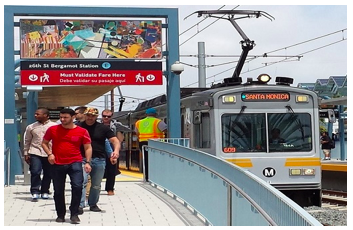CommentsTRANSIT TALK-Call it an obsession with mobility. Chicago, Montreal, New York, Los Angeles and a drive across Illinois, Indiana, Ohio, Pennsylvania, New Jersey, New York State and Massachusetts. This month, “I’ve Been Everywhere” is the song I have been singing in my best imitation of Johnny Cash.
I take in a lot when I am on the road. Fumes and carbs for sure, but also a lot about how we as a nation tackle the challenge of moving people from place to place. Here is how I see it: In our endless quest for the silver bullet of sustainable, cost-effective transportation, we tend to look at technology as our savior. One week it is Uber and Lyft, Juno and Via. The next it is autonomous vehicles. But tech is an enabler, not the messiah.
Just as many North American cities were surprised to find promising transportation solutions like bus rapid transit (BRT) in unlikely places like Curitiba, Brazil and Bogota, Colombia, perhaps we are still largely failing to look under the right rocks for our next generation mobility solutions. Like L and Q train riders in New York and Red Line riders on the El in Chicago, we miss our stop because we are glued to our screens. Even the transportation scholars among us often overlook the desire paths cut by pedestrians finding the fastest route mid-block across a busy Manhattan street. And of course, few cities have the luxury of building their transportation network from scratch, underscoring the necessity to bootstrap and adaptively reuse existing transit systems, rail rights of way, streets and highways.
While virgin subway construction like LA’s long-delayed Wilshire extension is critical, we should also be exhaustively studying what is working for moving large numbers of people in cities around the world. This bias toward empirical study paired with data analytics stems from my experience living and commuting in several transit meccas before finding myself in the capital of gridlock working toward a more transit- and active transportation-oriented Los Angeles.
Sometimes it is the organic solutions hidden behind the curtain that hold the most promise for safely moving commuters and others to their destination. Take for example LA Metro’s light rail Expo Line to Santa Monica (built along an old rail right of way), Metrocable, Medellín, Colombia’s system of gondolas or the 606 in Chicago. Sometimes, our best ideas about urban mobility and placemaking sit overlooked and undeveloped until smart planners recalibrate their gaze and see how the public is using (or might use) what it has to get to work or home from school.
Other lessons: It is encouraging to see NYC MTA adding bike racks to its SBS/BRT buses in Queens and the Bronx. Los Angeles and other cities in the Southwest long ago recognized the critical importance of this low-cost first, last mile solution for the transit dependent. In general, much greater integration of transit with biking, rideshare and other first, last mile solutions is critical to improving urban mobility. New York’s embrace of a growing system of water taxis is another smart and scenic transportation solution for those lucky enough to have one nearby.
On a personal level, working in support of Measure M, LA County’s transportation sales tax initiative, underscored how we are often falling short in serving the transportation needs of older adults. The Yes on M coalition wisely worked with AARP (which offered then-unprecedented support for a tax) to engage older adults and seniors in the collaborative, nonpartisan effort to find solutions to the region’s transportation challenge. It worked! Measure M won at the polls with backing from over 71 percent of Los Angeles County voters.
It shouldn’t have taken a crisis like New York’s Summer of Hell to awaken New Yorkers to the urgency of the generally excellent transit system’s declining health. But perhaps it was also unrealistic to think that congestion pricing would pass and the New York Legislature would take action without a bottom up campaign by Gotham’s residents of all political and economic persuasions to permanently endow New York’s transportation system with the money it requires to expand and maintain its existing equipment in a condition-based state of good repair.
These are the central lessons of the Measure M experience. Since transit doesn’t build itself, now is the time to get to work in New York and elsewhere fostering those cross-silo mobility coalitions.
(Joel Epstein is a senior advisor to companies, law firms, foundations and public initiatives on communications strategy, corporate social responsibility (CSR), recruiting and outreach. He is a contributor to CityWatch and can be contacted at [email protected].) Prepped for CityWatch by Linda Abrams.
-cw














